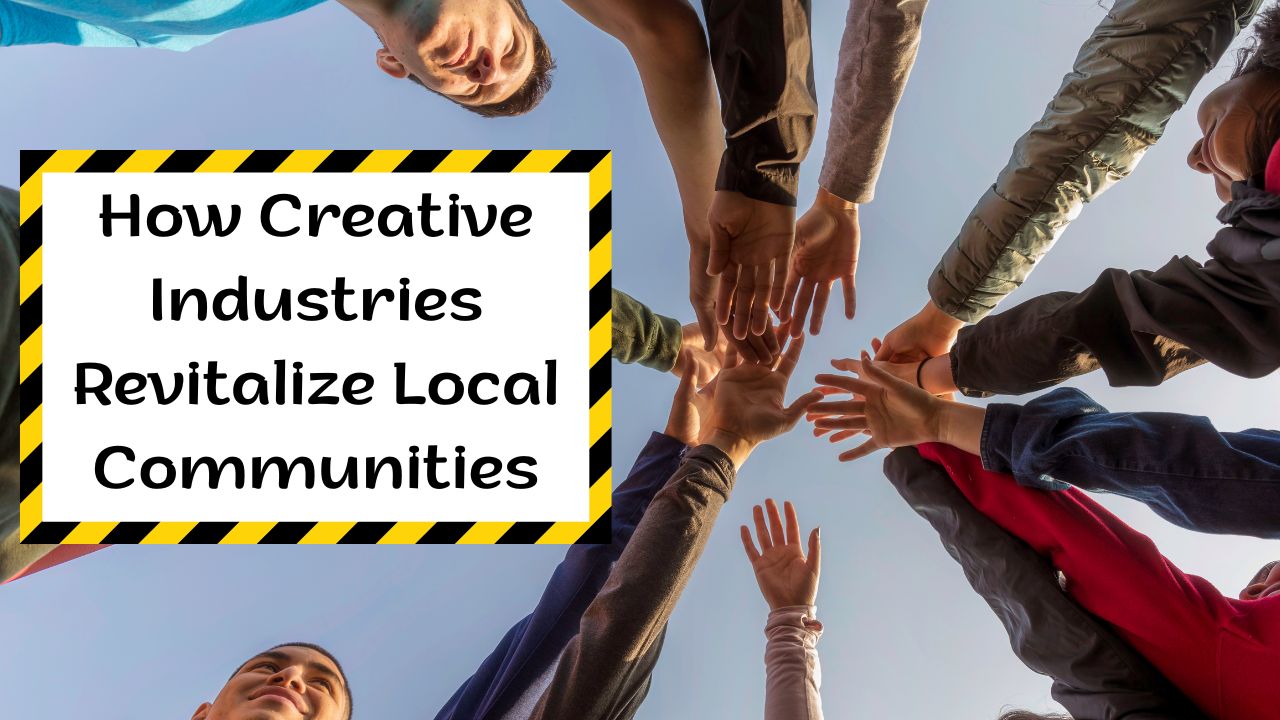Creative industries—spanning art, design, music, media, crafts, film, fashion, and cultural heritage—are not just about enjoyment or aesthetics. They have emerged as strategic engines of local revitalization, especially in regions that struggle economically.
By injecting jobs, identity, tourism appeal, and innovation, they help transform neighborhoods, towns, and cities.
In this article, we explore how creative industries revitalize local communities, presenting recent data, real-world examples, mechanisms of change, risks, and advice for communities aiming to harness this power.
The Scale & Significance of Creative Industries
- The creative economy contributes about 6.1 % of global GDP, with national shares often ranging between 2 % and 7 %.
- Creative sectors generate nearly 30 million jobs globally, employing especially younger cohorts.
- In many countries, the cultural and creative sectors account for up to 1 – 2 % of national employment and 1 – 3 % of value added.
- These sectors often have strong spillover effects into tourism, innovation, social cohesion, and urban regeneration.
These figures reveal that creative industries are not niche—they are vital levers of both economic and social change.
How Creative Industries Stimulate Local Revitalization
1. Economic Multipliers & Job Creation
By creating jobs in arts, media, design, cultural services, creative industries often anchor micro and small enterprises. These generate demand for supporting services—cafés, galleries, local retail, events, hospitality—creating multiplier effects in local economies.
2. Place Branding & Attraction
Art festivals, murals, cultural districts, open studios, museums, and street performance turn forgotten neighborhoods into attractions. These help rebrand places, draw foot traffic, visitors, and new residents, and raise local pride.
3. Adaptive Reuse & Urban Renewal
Creative enterprises often repurpose derelict buildings—warehouses, old factories, historic structures—into studios, galleries, coworking spaces. This not only preserves heritage but reactivates underused spaces, enhancing streetscape vitality.
4. Innovation & Cross-Sector Linkages
Creative thinking spills into other sectors. Design and media influence product development; storytelling boosts tourism marketing; interactive arts fuel new digital media or AR experiences. This cross-pollination enriches the broader economy.
5. Social Inclusion & Community Cohesion
Creative projects often involve local residents—workshops, cultural participations, public art. These strengthen social capital, give voice to marginalized groups, and help make development more inclusive.
Real-World Examples
- Wasps Studios, Scotland
This arts organization acquires and restores derelict buildings to convert them into affordable studio and community arts spaces across various towns — supporting hundreds of artists, increasing local creative output, and catalyzing broader regeneration in adjacent areas. - Salford, UK (BBC relocation)
When the BBC moved hundreds of jobs to Salford, the city saw ancillary creative sector job growth: each relocated public sector creative role stimulated nearly 0.55 private creative industry jobs, boosting employment share and spawning new creative businesses. - Greater Phoenix, Arizona
The creative economy in Phoenix boasts output of over USD 15.8 billion, with ~100,000 jobs supported statewide, showing that strategic cultural investment yields scale, even in mid-tier metro regions.
These cases show how creative anchors can shift local trajectories.
Mechanisms, Challenges & Enabling Conditions
1. Key Enablers
- Supportive policy frameworks: Grants, tax incentives, zoning that allows creative use of space
- Access to affordable space & infrastructure: Low-cost studios, rehearsal spots, maker labs
- Capacity building & networking: Workshops, business training, platforms connecting creative actors
- Strategic partnerships: Cities collaborating with universities, NGOs, private sector
- Community inclusion: Projects co-designed with locals to avoid exclusion or displacement
2. Common Challenges
- Gentrification pressure: Rising property values may displace original residents
- Precarious employment: Many creatives work freelance or in informal setups
- Sustainability of funding: Arts and culture often face budget cuts, lack of stable revenue
- Uneven scale: Smaller towns may lack critical mass or cultural assets to kickstart transformation
Key Facts at a Glance
| Theme | Details / Figures |
|---|---|
| Global GDP Share | ~ 6.1 % from creative economy |
| Jobs Created | ~ 30 million globally in creative & cultural sectors |
| Employment Share in OECD | Up to 1 in 20 jobs in some nations |
| Value Added | 1 – 3 % of GDP in many countries |
| Phoenix Example | USD 15.8 billion in creative output; ~100,000 jobs |
| Multiplier Effects | Creative anchors often trigger cafe, retail, event sectors growth |
| Risks | Gentrification, funding instability, informal labor, scale limits |
Strategies for Local Implementation
- Map local creative assets (artists, spaces, proposals) and identify low-cost buildings for adaptive reuse.
- Launch pilot cultural projects—festivals, murals, pop-ups, open studios—to stimulate initial momentum.
- Foster creative clusters or districts, enabling collaboration, foot traffic, shared services.
- Ensure inclusive development by reserving space or subsidies for local underserved groups.
- Establish long-term funding mechanisms: culture funds, matching grants, sponsorships, public–private partnerships.
- Integrate creative industries into wider planning—transport, tourism, economic strategy—to maximize synergies.
What to Watch: Success Indicators
- Growth in creative enterprises and jobs in target area
- Increase in visitor footfall, cultural events, and tourism revenue
- Rise in local business turnover (cafes, shops, services) around creative zones
- Stability or reduction in resident displacement rates
- Balanced mix of commercial and community-led projects, avoiding overcommercialization
Creative industries not only spark economic growth, but also strengthen a community’s sense of belonging and local identity. When artists, entrepreneurs, and residents collaborate, they transform abandoned spaces into vibrant cultural centers that attract investment, tourism, and talent.
These industries also encourage youth participation, reduce unemployment, and foster innovation across education, design, and technology. Over time, creative initiatives can shift how people see their towns—from places of decline to hubs of possibility.
With continued support, transparency, and inclusive planning, creative industries can build sustainable ecosystems where culture and commerce thrive together for generations to come.
FAQs
Can small towns without big artists or institutions benefit from creative industries?
Yes. Impact can begin through small-scale projects—street murals, artisan markets, cultural festivals. Even modest creative anchors can seed momentum if local stakeholders commit and scale up over time.
How to prevent gentrification when arts cause rising property values?
Implement protective measures: rent caps for long-term residents, community land trusts, reserved affordable housing, inclusionary zoning, and a mix of commercial/community uses.
What funding models work best for sustaining creative infrastructure?
A combination: public grants, philanthropic support, revenue from ticket or service sales, cultural levies (small fees on tourism or hotel taxes), and public–private partnerships ensure a diversified, resilient funding base.

